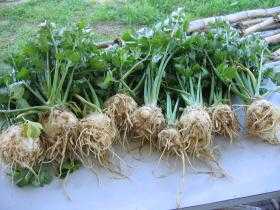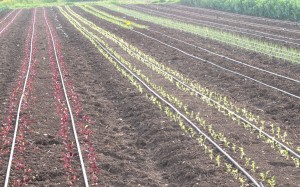Winter is nearing its end, though we probably still have some storms in store (we’re still waiting for some rain!). The temperatures are warming up and the vegetables are growing beautifully. December’s frost is beginning to defrost, and we are renewing our planting and seeding in the field. Spring potatoes have been planted in nicely-heaped beds (they’re called “spring” because they will be gathered from the field in springtime), fennel, celery, cabbage and lettuce have had another round of winter plantings, and kohlrabi, Swiss chard, cauliflower, broccoli and beets will join them this week. This is our final winter planting. Next month we begin end-of-winter-beginning-of-spring planting.
Another sign that winter is entering its second half is that beginning this week, you can add delectable goat milk products from the excellent dairy of Meshek 42 in Tal Shachar. In our last newsletter we discussed this dairy in detail, and this week Puah’s words will be translated into actual flavors. May we all have a great journey together! You can order these milk products from our order system—just please do it in advance so they have ample time to prepare. Likewise, please order Maggie’s sprouts a few days in advance as well. It’s best to make a standing order, as the sprouting is done a week in advance.
Over the past few weeks, your boxes have been visited by an interesting creature, whose different titles prove that it’s all really a matter of perspective. The celery head or celery root, no matter what you call it, is proof that winter is on and that the time is ripe for stews and soups. This week, the spotlight is on The Celeriac, from a newsletter we dedicated to him from two years ago.
Rooting for Celery
Wintertime is the kingdom of the root vegetables. One of its most wonderful, though weird-looking members (some say ugly, but why judge?) is the celeriac that has been frequenting your boxes for some weeks now. I would wager a guess that it automatically goes into your soup. But it actually has many varied uses and even a cool story. In its honor, this newsletter brings back some old, but slightly spruced up, news about the celeriac:
There are many who think he’s evil, for some reason. In a futuristic comic strip titled Star Fruit Wars, there is a description of the battle the fruits and vegetables wage against mean old Celeriac, the evil celery tuber possessing super powers, who is trying to take over the world. But he only looks tough…
Though on the outside, the celery tuber looks somewhat monster-like; rough, gnarled and usually dirty, it is one of those creatures that harbors inner beauty which should not be missed, especially during its season — a rainy, cold winter. Those who like the celery root will grant it its due respect, and even though it grows underground will affectionately call it a “celery head.” It tastes a bit like a cross between celery and parsley, similar to celery stalks, but sweeter and refined.
The celeriac, like its sibling the leafy celery, is a cultivated species. It was grown over the years by farmers vying for its thick root, thus seasonally selecting the celery variety producing the thickest, largest root. In its case, the stems remained short and thin, with a much more dominant taste than leaf celery. In certain cases, the stems are also hollow like a straw. When you look at a stalk celery bed next to a celeriac bed, it’s easy to tell the difference by the way the leaves grow. The former are erect and long, the latter chubby and spread out.
Celery grows slowly. It starts with tiny seeds that take their sweet time, three to five weeks, till they sprout. After this initial sprout, they need at least two months of devoted treatment in the warm temperature and protected environment of the nursery. Only after minimum three months are they ready for planting. In our first year, we sowed celery ourselves in our plant hothouse, but the long process of tending to our “preemies” made it clear that we’d do better to buy the plants. Since then, we receive our toddlers at the age of three months, ready to leave their cube for the bountiful earth.
This is how they look when they’re planted fresh in the damp wintery earth:
Celery loves fertile earth and lots of water. Originally it was a swamp plant, hence it adores humidity while in the earth and also during storage — which is why in Israel it grows during wintertime. The Israeli summer is difficult and dry for the celery.
After three months in the nursery, it needs three additional months to ripen if picked for its leaves/stems. The variety that develops a thicker root is more patient, cuddling under the warm blanket of earth for another month, as if unwilling to leave a warm bed to face the cold winter. A careful calculation will lead you to the conclusion that the silly little ball in your box these weeks started its journey from seed to tuber seven months ago!
And although its time has come, the celeriac holds on to earth for dear life, and it’s not easy to convince him to come out and hop into your boxes. When we harvest the celeriac, we use knives to gently release it by cutting the thin roots that surround it. After it emerges, we try to shake the tuber well and cut off more of the clumps of earth that still are caught in it. After this preliminary cleansing, it is soaked in our special vegetable-washing bathtubs. Even so, it will probably still arrive in your kitchen carrying some remnants of dirt. Soak it in water for half an hour to make the final cleaning much easier.
The celeriac’s history is similar to that of its swifter brother, the leaf celery. It too was cultivated from the wild breed that grew in European swamps, and east of the Himalayas. It was most probably domesticated somewhere in the Middle East, and was of medicinal value in ancient Egypt, China, Greece and Rome. Apparently, only in medieval times was the celeriac used as a vegetable, first described in Italian and Swiss botanical books of the 16th century, and gaining popularity in the 19th century.
The celeriac is a very popular, widespread vegetable in Middle-Eastern countries and in Europe. Here is the celeriac in a view from above:
In Israel, the celeriac is known mostly as a soup vegetable. In Europe, however, it is scalded, cooked or stuffed, or even served raw with some lemon juice to keep it from turning brown. In a classic French recipe, Céleri-Rave Rémoulade, it is served raw, cut into match-like sticks, dressed in lemon juice, mayonnaise and mustard. In Spanish Jewry tradition, it is a major component in the cooked salad Apiu Ilado. Celeriac goes well with potatoes, apples, lemon juice and cheeses. So try using it creatively: puree, make a quiche, grill it along with other root vegetables, slice thinly and bake like French fries, add it raw to salads- use your imagination. And check out the many more ideas in this week’s Recipe Corner!
May we all be granted a generous raise in celery!
Wishing wintery health, happiness, cuddling, and warm and nurturing food to all,
Alon, Bat Ami, Maya, Dror and the Chubeza team
WHAT’S IN THIS WEEK’S BOXES?
Monday: Dill/parsley, Jerusalem artichoke/peas, lettuce, tomatoes, daikon/radishes, scallions/leeks, cucumbers, broccoli, spinach/kale, cauliflower/cabbage. Small boxes only: celeriac
Large box, in addition: Fennel, carrots, potatoes, beets/turnips
Wednesday: spinach/tatsoi, daikon/kohlrabi, cucumbers, cabbage/cauliflower, parsley, broccoli, lettuce, leek/scalions, tomatoes, Jerusalem artichoke/peas/potatoes, small boxes only: celeriac
Large box, in addition: turnip/beets, carrots, fennel/peppers, kale/broccoli greens
And there’s more! You can add to your basket a wide, delectable range of additional products from fine small producers: flour, sprouts, fruits, honey, dates, almonds, crackers, probiotic foods, dried fruits and leathers, olive oil, bakery products, pomegranate juice and goat dairy too! You can learn more about each producer on the Chubeza website. On our order system there’s a detailed listing of the products and their cost, you can make an order online now!



